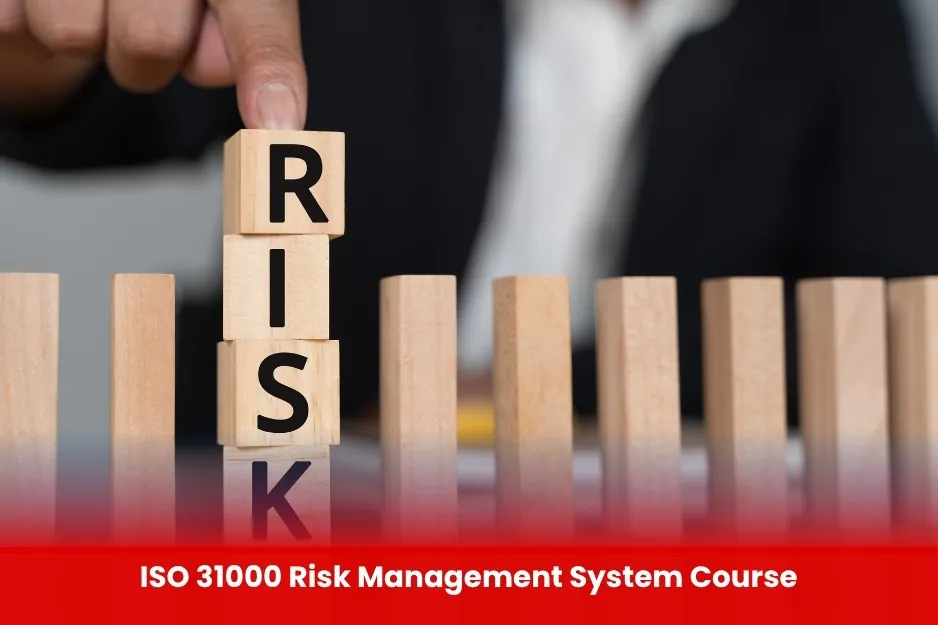ISO 31000 Risk Management System Course
ISO 31000 is an international standard that provides principles, a framework, and a process for managing risk in a structured, transparent, and effective manner. It is applicable to any organization, regardless of size, industry, or sector, and supports strategic decision-making by addressing uncertainty and improving resilience.
Rather than focusing on specific types of risk (such as financial or operational), ISO 31000 offers a unified approach to risk management that integrates seamlessly into an organization’s overall governance, leadership, and culture. It encourages proactive thinking, informed choices, and continuous improvement in risk-based decision-making across all levels of an organization.

Aim of ISO 31000 Risk Management System
The aim of ISO 31000 is to provide organizations with a structured and universally applicable framework for identifying, assessing, treating, monitoring, and communicating risk across all functions and levels. It supports organizations in making informed, evidence-based decisions that enhance their ability to achieve objectives, improve performance, and foster a proactive risk-aware culture.
Course Overview
ISO 31000 Risk Management System Course
Minimum Requirements:
- Basic education (high school diploma or equivalent)
- Interest or involvement in organizational risk, compliance, safety, or decision-making processes
| Course Code | Curriculum Title | Credit | DLH |
|---|---|---|---|
| BUK1932-1 | Introduction to Risk Management | 3 | 15 |
| BUK19322 | Principles of Risk Management | 3 | 15 |
| BUK1932-3 | Framework for Managing Risk | 3 | 15 |
| BUK1932-4 | Risk Management Process (Core) | 3 | 15 |
| BUK1932-5 | Context and Risk Criteria Setting | 3 | 15 |
| BUK1932-6 | Risk Assessment Techniques | 3 | 15 |
Module 1: Introduction to Risk Management
- What is risk?
- Importance of risk management in today’s business environment
- Overview of ISO 31000 and its global relevance
- Benefits of implementing ISO 31000
Module 2: Principles of Risk Management
- The 8 principles of ISO 31000 (e.g., integrated, structured, customized, inclusive, dynamic)
- How these principles guide effective risk management
- Linking risk management with organizational objectives
Module 3: Framework for Managing Risk
- Components of the risk management framework:
- Leadership and commitment
- Integration into organizational systems
- Resources, roles, responsibilities, and accountability
- Communication and reporting
- Continuous improvement
- Aligning risk management with governance and culture
Module 4: Risk Management Process (Core)
- Step-by-step breakdown of the ISO 31000 risk management process:
- Risk identification
- Risk analysis
- Risk evaluation
- Risk treatment
- Monitoring and review
- Communication and consultation
- Recording and reporting
Module 5: Context and Risk Criteria Setting
- Establishing the internal and external context
- Defining scope, boundaries, and risk criteria
- Understanding stakeholders and objectives
Module 6: Risk Assessment Techniques
- Qualitative vs. quantitative assessments
- Common tools: risk registers, probability-impact charts, FMEA, bowtie analysis
- Case study walkthroughs
Module 7: Risk Treatment Planning
- Selecting appropriate risk responses (avoid, reduce, share, accept, exploit)
- Developing action plans and controls
- Residual risk assessment
Module 8: Embedding Risk into Decision-Making
- Aligning risk management with strategic planning
- Risk-based thinking in projects and operations
- Using risk information for better decisions
Module 9: Monitoring, Review, and Continual Improvement
- How to measure risk performance
- Reviewing controls and updating risk registers
- Audit and review processes
- Role of feedback and learning in risk maturity
Module 10: Implementation Roadmap & Case Studies
- Steps to implement ISO 31000 in your organization
- Common challenges and how to overcome them
- Real-world examples from industry
- Risk Managers / Risk Officers
- Health, Safety, Environment, and Quality (HSEQ) Professionals
- Compliance and Governance Officers
- Project Managers and Engineers
- Internal Auditors and Quality Managers
- Finance and Operations Managers
- Business Continuity and Emergency Planning Professionals
- Consultants and Trainers
- Students and Graduates
- All Modules within this qualification are assessed internally by the approved training Centre and externally verified by BURRAQ UK. The program uses a criterion-referenced assessment approach to ensure that learners successfully meet all required learning outcomes.
- A Pass in any unit is granted only when the learner submits valid, reliable, and authentic evidence that demonstrates achievement of the assessment criteria. The Assessor is responsible for reviewing this evidence and confirming that the learner has attained the expected standard.
